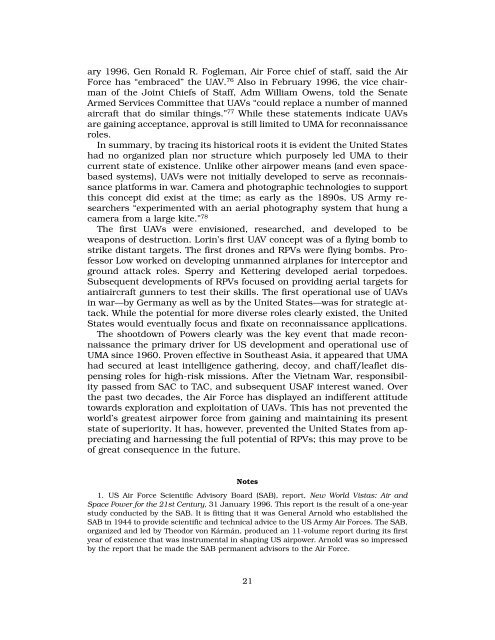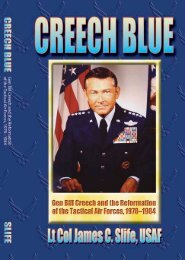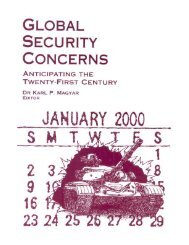Expendable Remotely Piloted Vehicles for Strategic Offensive ...
Expendable Remotely Piloted Vehicles for Strategic Offensive ...
Expendable Remotely Piloted Vehicles for Strategic Offensive ...
Create successful ePaper yourself
Turn your PDF publications into a flip-book with our unique Google optimized e-Paper software.
ary 1996, Gen Ronald R. Fogleman, Air Force chief of staff, said the AirForce has “embraced” the UAV. 76 Also in February 1996, the vice chairmanof the Joint Chiefs of Staff, Adm William Owens, told the SenateArmed Services Committee that UAVs “could replace a number of mannedaircraft that do similar things.” 77 While these statements indicate UAVsare gaining acceptance, approval is still limited to UMA <strong>for</strong> reconnaissanceroles.In summary, by tracing its historical roots it is evident the United Stateshad no organized plan nor structure which purposely led UMA to theircurrent state of existence. Unlike other airpower means (and even spacebasedsystems), UAVs were not initially developed to serve as reconnaissanceplat<strong>for</strong>ms in war. Camera and photographic technologies to supportthis concept did exist at the time; as early as the 1890s, US Army researchers“experimented with an aerial photography system that hung acamera from a large kite.” 78The first UAVs were envisioned, researched, and developed to beweapons of destruction. Lorin’s first UAV concept was of a flying bomb tostrike distant targets. The first drones and RPVs were flying bombs. ProfessorLow worked on developing unmanned airplanes <strong>for</strong> interceptor andground attack roles. Sperry and Kettering developed aerial torpedoes.Subsequent developments of RPVs focused on providing aerial targets <strong>for</strong>antiaircraft gunners to test their skills. The first operational use of UAVsin war—by Germany as well as by the United States—was <strong>for</strong> strategic attack.While the potential <strong>for</strong> more diverse roles clearly existed, the UnitedStates would eventually focus and fixate on reconnaissance applications.The shootdown of Powers clearly was the key event that made reconnaissancethe primary driver <strong>for</strong> US development and operational use ofUMA since 1960. Proven effective in Southeast Asia, it appeared that UMAhad secured at least intelligence gathering, decoy, and chaff/leaflet dispensingroles <strong>for</strong> high-risk missions. After the Vietnam War, responsibilitypassed from SAC to TAC, and subsequent USAF interest waned. Overthe past two decades, the Air Force has displayed an indifferent attitudetowards exploration and exploitation of UAVs. This has not prevented theworld’s greatest airpower <strong>for</strong>ce from gaining and maintaining its presentstate of superiority. It has, however, prevented the United States from appreciatingand harnessing the full potential of RPVs; this may prove to beof great consequence in the future.Notes1. US Air Force Scientific Advisory Board (SAB), report, New World Vistas: Air andSpace Power <strong>for</strong> the 21st Century, 31 January 1996. This report is the result of a one-yearstudy conducted by the SAB. It is fitting that it was General Arnold who established theSAB in 1944 to provide scientific and technical advice to the US Army Air Forces. The SAB,organized and led by Theodor von Kármán, produced an 11-volume report during its firstyear of existence that was instrumental in shaping US airpower. Arnold was so impressedby the report that he made the SAB permanent advisors to the Air Force.21






